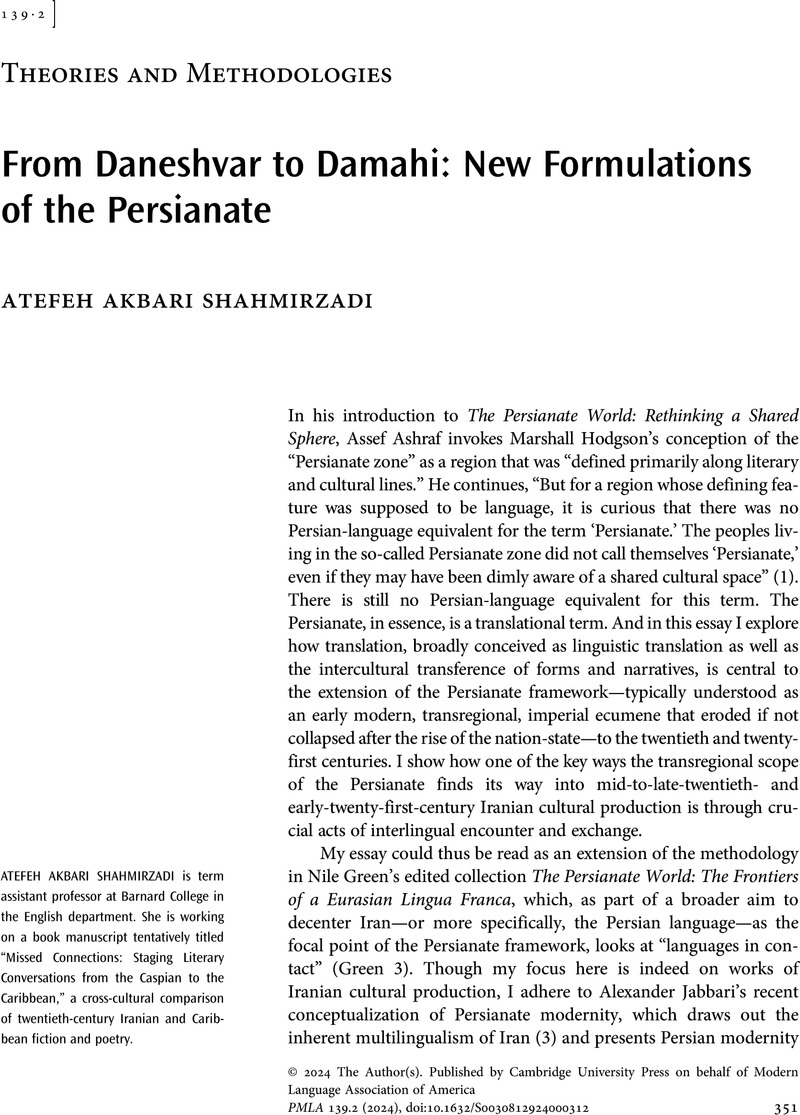No CrossRef data available.
Article contents
From Daneshvar to Damahi: New Formulations of the Persianate
Published online by Cambridge University Press: 26 July 2024
Abstract
An abstract is not available for this content so a preview has been provided. Please use the Get access link above for information on how to access this content.

- Type
- Theories and Methodologies
- Information
- Copyright
- Copyright © 2024 The Author(s). Published by Cambridge University Press on behalf of Modern Language Association of America
References
Works Cited
Ashraf, Assef. “Pathways to the Persianate.” Introduction. The Persianate World: Rethinking a Shared Sphere, edited by Amanat, Abbas and Ashraf, , Brill, 2019, pp. 1–14.Google Scholar
Baghoolizadeh, Beeta. “From Religious Eulogy to War Anthem: Kurdizadeh's ‘Layla Bigufta’ and Blackness in Late Twentieth-Century Iran.” Comparative Studies of South Asia, Africa and the Middle East, vol. 41 no. 3, 2021, pp. 441–54. Project Muse, muse.jhu.edu/article/840297.CrossRefGoogle Scholar
Baldwin, James. “Stranger in the Village.” Notes of a Native Son, rev. ed., Beacon Press, 2012, pp. 163–79.Google Scholar
Beizaei, Bahram, director. باشو، غریبه ی کوچک [Bashu, Gharibeh-ye Kuchak]. کانون پرورش فکری کودکان و نوجوانان [Kanoon Parvaresh Fekri-e Koodakan va Nojavanan], 1986.Google Scholar
Damahi. بی امان [“Bi Aman”]. در من برو شکار [Dar Man Boro Shekar], 2019. Spotify, open.spotify.com/track/2HPYHJxHzjxyYt017bVDKP?si=4a3b4ac6ff814168.Google Scholar
Damahi. بی امان [“Bi Aman”]. “Damahi.” Spotify, 2024, open.spotify.com/artist/0oQRKnW4LrHJMh3Uj5CrdV.Google Scholar
Damahi. بی امان [“Bi Aman”]. دیوانه [“Divaneh”]. در من برو شکار [Dar Man Boro Shekar], 2019. Spotify, open.spotify.com/track/05B3zqDNhSrAuM08e3RDX0?si=8fcddd3fa5ac416e.Google Scholar
Damahi. بی امان [“Bi Aman”]. هوچراغی [“Hocheraghi”]. در من برو شکار [Dar Man Boro Shekar], 2019. Spotify, open.spotify.com/track/7zKp3gHCuHYOKaQBppFM14?si=b455a6ce892d4c3d.Google Scholar
Damahi. بی امان [“Bi Aman”]. مصاحبه با داماهی [“Mosahebeh ba Damahi”]. Musicema.com, musicema.com/Damahi-Interview-98. Accessed 16 Oct. 2023.Google Scholar
Daneshvar, Simin. A Persian Requiem. Translated by Zand, Roxane, Haliban Publishers, 2002.Google Scholar
Daneshvar, Simin. Savushun: A Novel about Modern Iran. Translated by Ghanoonparvar, M. R., Mage Publishers, 2001.Google Scholar
Fani, Aria, and Schwartz, Kevin L.. Introduction. Persianate Pasts; National Presents: Persian Literary and Cultural Production in the Twentieth Century, special issue of Iranian Studies, edited by Fani, and Schwartz, , vol. 55, no. 3, 2022, pp. 605–09, https://doi.org/10.1017/irn.2022.31.Google Scholar
Friedman, Susan Stanford. “Why Not Compare?” Comparison: Theories, Approaches, Uses, edited by Felski, Rita, Johns Hopkins UP, 2013, pp. 34–45.Google Scholar
Golshiri, Houshang. جدال نقش با نقاش در آثار سیمین دانشور (از آتش خاموش تا سووشون ) [Jedal-e Naqsh ba Naqqash dar Asar-e Simin Daneshvar (Az Atash-e Khamush ta Savushun)]. Niloufar Publications, 1998.Google Scholar
Gould, Rebecca Ruth. Afterword. Persianate Pasts, National Presents: Persian Literary and Cultural Production in the Twentieth Century, special issue of Iranian Studies, edited by Fani, Aria and Schwartz, Kevin L., vol. 55, no. 3, 2022, pp. 787–89, https://doi.org/10.1017/irn.2022.34.Google Scholar
Green, Nile. “The Frontiers of the Persianate World (ca. 800–1900).” Introduction. The Persianate World: The Frontiers of a Eurasian Lingua Franca, edited by Green, U of California P, 2019, pp. 1–71.Google Scholar
Jabbari, Alexander. The Making of Persianate Modernity: Language and Literary History between Iran and India. Cambridge UP, 2023.CrossRefGoogle Scholar
Koolaghani, Reza. Interview with the author. 11 Oct. 2023.Google Scholar
Martin, Tenley. Transnational Flamenco: Exchange and the Individual in British and Spanish Flamenco Culture. Palgrave Macmillan, 2020.CrossRefGoogle Scholar
Matras, Yaron, and Shabibi, Maryam. “Grammatical Borrowing in Khuzistani Arabic.” Grammatical Borrowing in Cross-Linguistic Perspective, edited by Matras, Jeanette Sakel, , Mouton de Gruyter, 2007, pp. 137–49, https://doi.org/10.1515/9783110199192.137.CrossRefGoogle Scholar
Naficy, Hamid. A Social History of Iranian Cinema, Volume 4: The Globalizing Era, 1984–2010. Duke UP, 2012, https://doi.org/10.1215/9780822393542.Google Scholar
“Planet.” Oxford Dictionary of Word Origins, edited by Cresswell, Julia, Oxford UP, 2021, www.oxfordreference.com/display/10.1093/acref/9780199547920.001.0001/acref-9780199547920-e-3778.CrossRefGoogle Scholar
Rahimieh, Nasrin. “Marking Gender and Difference in the Myth of the Nation.” Thamyris, vol. 3, no. 2, autumn 1996, pp. 261–77.Google Scholar
Washabaugh, William. “Ironies in the History of Flamenco.” Theory, Culture, and Society, vol. 12, no. 1, 1955, pp. 133–55, https://doi.org/10.1177/026327695012001006.CrossRefGoogle Scholar




